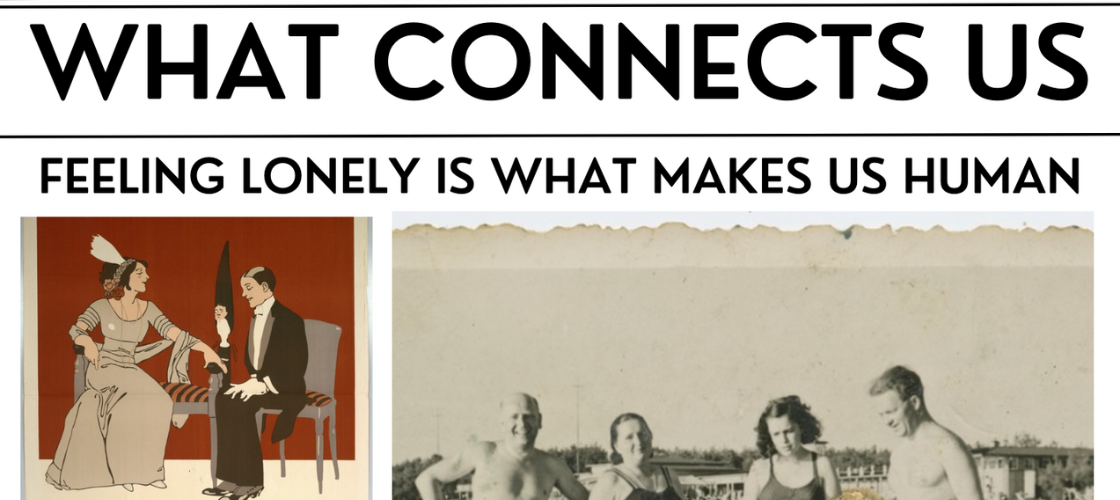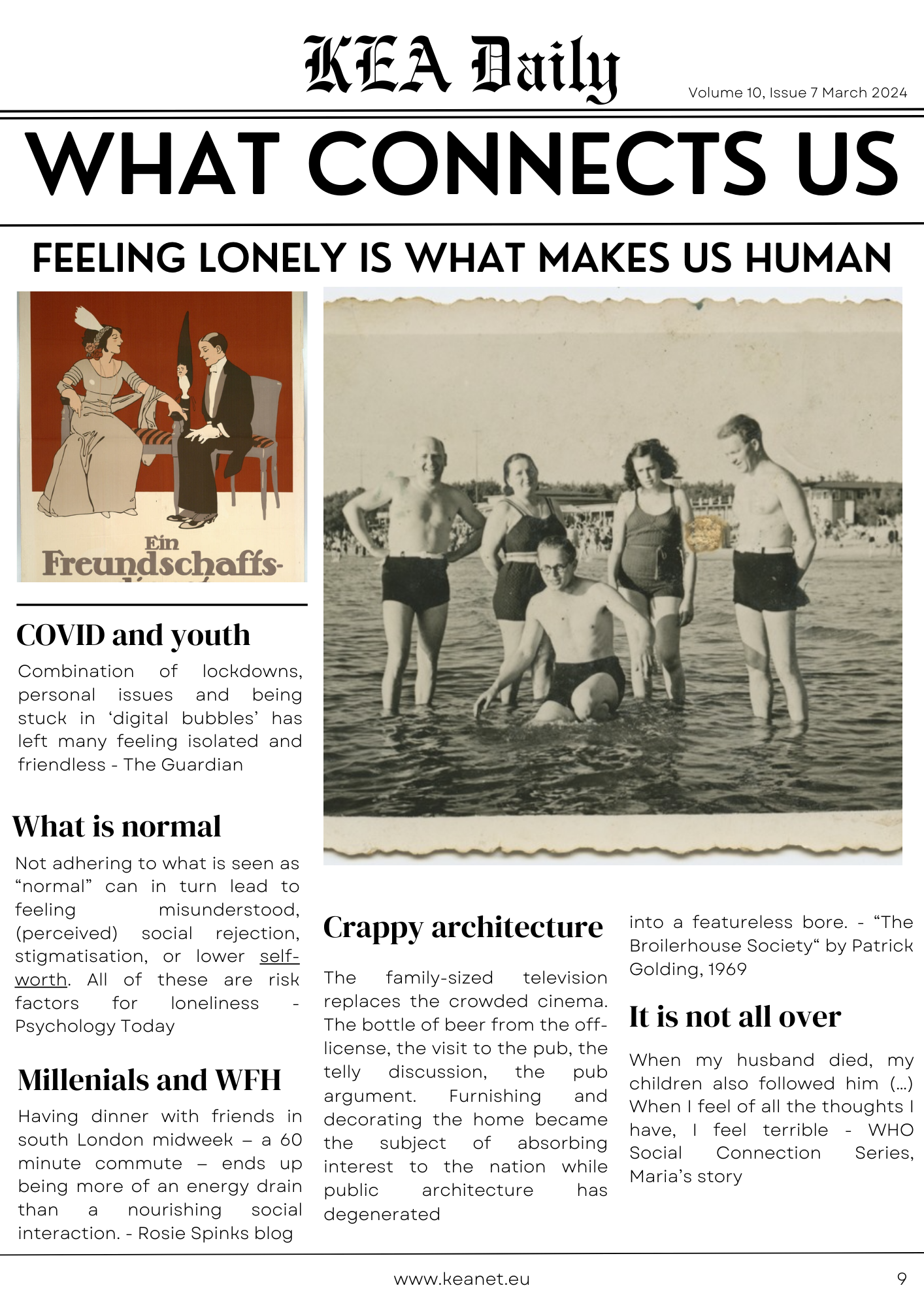
Feelings of loneliness arise when social relationships fail to meet the quantity and quality required for individuals’ social needs. Loneliness is not only a personal struggle but a health concern as well. Its association with significant physical and mental health rivals risk factors like smoking and excessive drinking. Moreover, loneliness contributes to increased public health expenditures, with lonely individuals frequently utilising medical services. The ongoing investigations by the World Health Organization (WHO) yield results. The WHO Commission on Social Connection (2024–2026) seeks to elevate the recognition of this issue, designating it as a global public health priority. The Commission aims to present an international agenda on social connection. Loneliness, as it turns out, is a health problem on a scale that should no longer be ignored. The internet, our global agora, is abuzz with content discussing the escalating and detrimental health issue of isolation, especially as traditional methods for meeting new people lose their appeal.
Cultural third places
Here marks the initial reference to culture and sports as potential solutions. Borrowing sociological terms, we live in a “broilerhouse society” (Goldring 1969) and lack “third places” (Oldenburg 1989). The third place is essential for every human being, after the first two: home and work (or school). The main characteristic of a third place is that we don’t have to be there, but we choose to. In his book “The Great Good Place” (1989), Ray Oldenburg argues that third places are essential for civil society, democracy, civic engagement, and establishing feelings of a sense of place. Examples include churches, gyms, public libraries, drama or language classes, volunteering at animal shelters, cafes, shopping malls – you name it. Read this article in the UNESCO Courier to understand how important cafes are for our collective sanity! Notwithstanding, the authors behind “Third Places: Restoring Civic Life and Resisting Consumerism” warn that “we occupy increasingly thin, homogenised, placeless environments.”
Insert culture. In his article on cultural third places, Raphaël Besson cites fascinating examples of the transformation of public libraries, museums, galleries, and former industrial sites. Previously associated with one type of service, such as lending books or displaying modern art in an aesthetic space, these institutions now offer a myriad of offers, primarily workshop and laboratory-based, engaging visitors to disrupt their daily routine. Although, at first glance, this is a transformation for the benefit of all involved, it is possible that beneath the first layer of success lies an effort to solve the problem of dwindling public funds for cultural institutions. The truth is that transforming cultural places into third places is not without problems, as Besson enumerates many of these issues. Still, everything boils down to suitable cultural investments that cannot be ignored.
At KEA, through numerous case studies, we have been recommending balanced public policies, emphasising how access to culture and the development of cultural places contribute to well-being and social cohesion. In the short paper “Future creative cities. Why culture is a smart investment in cities” (2017), we list the steps cities should take to support a culture that benefits their residents on both sides of cultural production, including artists and employees in cultural institutions, as well as audiences.
Loneliness sans frontiers
Contrary to intuition, loneliness can happen to anyone, anywhere. Research contradicts the idea that there are societies where loneliness is less likely. Perhaps this is possible locally where relationships are well-maintained, but this small, well-connected group can appear at any geographical latitude and have members from every generation. And vice versa, any place can have a shortage of social connectedness.
If you would like to listen to personal accounts, check out an online exhibition, “Loneliness Across Cultures.” It proves that sometimes, all it takes to feel lonely is being a human (in this case, as for what we know, humans are not the only species who need a pack and can experience a deep need and nostalgia for a company). Notably, some exhibition protagonists mention enjoyment and creativity on the long list of remedies. It is possible to combat loneliness, although we understand that doing it all alone, pun unintended, is not easy.
At the end of 2023, along with experts from the EU and Ukraine, during Policy Labs organised by the ERSTE Foundation in Vienna, we tackled the impact of cultural heritage and artistic expression on well-being, especially in the context of the individual and collective shocks that war undoubtedly brings. Details of our recommendations are in the report. Similarly, in the paper for Creative Lash (2011), where we write about the benefits of creative intervention for organisations, we also describe the role of art in strengthening the social fabric and the local community. Artistic intervention enhances community resilience by fostering collaboration and networking within the arts. It involves exchanging knowledge and ideas, contributing to a societal vision prioritising environmental and sustainability concerns.
Additionally, it prompts critical reflection on post-recession values and the influence of growth imperatives on social connections. The arts play a vital role in improving the health and well-being of individuals and communities, with art serving as a source of inspiration. It provides elements for developing imaginative and creative solutions both in and outside the workplace.

Sources in the image:
“‘Socially stunted’: how Covid pandemic aggravated young people’s loneliness” https://www.theguardian.com/society/2023/jun/19/socially-stunted-how-covid-pandemic-aggravated-young-peoples-loneliness
“Is Loneliness Just a Problem in Individualistic Cultures?” https://www.psychologytoday.com/us/blog/lonely-not-alone/202309/is-loneliness-just-a-problem-in-individualistic-cultures-2
“The Friendship Problem” by Rosie Spinks https://rojospinks.substack.com/p/the-friendship-problem
“The Broilerhouse Society”, a book by Patrick Goldring, Frewin, 1969 – 226
The Social Connection Series: lived experiences of people around the world through film, WHO, https://youtu.be/HAN8S0BfTuM
Heritage photographs in the image by courtesy of Europeana:
Ein Freundschaftsdienst; MESSTER-FILM BERLIN by Julius Klinger (Künstler_in) – Albertina, Austria – Public Domain. https://www.europeana.eu/item/15508/DG2003_598
Seltskond Pirital – Tallinn City Museum, Estonia – CC BY. https://www.europeana.eu/item/401/item_KVISA2RX6LR23YEIEZNH5KT5DMK7IDPW